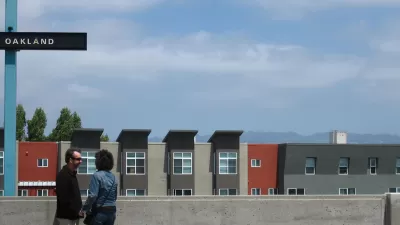As Sen. Wiener has announced new amendments to the controversial land use, transit-oriented development, and real estate bill, The Planning Report turns to three experts to unpack the legislation's consequences.

Despite its stated goals of promoting transit-oriented development and improving affordability through dense new housing supply, nearly every housing justice organization in California has vehemently opposed SB 827. In a series of interviews, The Planning Report aimed to drill down on the potential impacts of the bill, and depoliticize the contentious policy conversation.
In an interview with Michael Storper—accomplished economic geographer, director of UCLA Luskin’s Global Public Affairs program, and one of the most cited social scientists in the world—Storper was critical of the turn in the urban planning field toward simplistic, Laffer-esque supply-side economics.
Critiquing the "one-size-fits-all" priorities of today’s transit-oriented development urbanism, Storper cast doubt on the notion that merely adding density—unaccompanied by targeted policies to prevent displacement—will benefit the majority of urban residents stressed by unaffordable cost and access to the coastal housing market. Storper, who authored The Rise and Fall of Urban Economies to address the differences in economies like San Francisco and Los Angeles, provided context to the demographic breakdown of Los Angeles and the lack of impact most low and middle-income earners will feel from upzoning transit corridors. On SB 827, Storper stated that it is "naïve to think that this approach will help the bottom 60 percent of wage earners in an area like Southern California. It’s worth pointing out that some of the areas that will gain density will already be expensive—areas where land prices are already high—and some will be newly gentrifying areas."
However, Storper was not completely critical of the intentions of SB 827 and the overall intentions of Sen. Scott Wiener to address the state's housing problem through transit-oriented development. Ultimately, Storper was critical of the fact that SB 827's language is "a very blunt instrument," that would result in "all kinds of contradictory effects" in California.
TPR also turned to two experts on transit and equitable development: Denny Zane, leading transit advocate, former mayor of Santa Monica, and executive director of Move LA; and Cynthia Strathmann, executive director of Strategic Actions for a Just Economy (SAJE), a long-standing non-profit for equitable development and tenant rights in South Los Angeles.
Strathmann, echoing Storper's criticism of SB 827 for its lack of inclusiveness in the bill, noted that "the danger with SB 827 is that there is no mandatory affordability or preservation component." Upzoning transit-rich corridors without inclusionary components could lead to high-end luxury construction, which would exacerbate displacement pressures for low-income residents who are the actual users of transit. The increase in housing supply would not produce any housing that would actually make low-income residents more housing-secure. Strathmann also voiced concerns that SB 827 could really undermine the efforts that came to fruition with the People’s Plan for South LA, a long-term anti-displacement plan to growth South LA while uplifting lower-income communities of color.
"Some people believe that more density, in and of itself, will give us the benefits we need. They tend to advocate broad authorization of density, especially near transit corridors. I’m not convinced of that approach. I think that more housing density alone can actually have contradictory effects on cities. It affects where people live within the metro area; it affects who lives in the new housing; it affects how the metro area grows as a whole—that is, how much population growth it gets; and it affects affordability and inclusion. It’s like a four-dimensional puzzle—putting all those pieces together, you can get a lot of different answers."

Alabama: Trump Terminates Settlements for Black Communities Harmed By Raw Sewage
Trump deemed the landmark civil rights agreement “illegal DEI and environmental justice policy.”

Planetizen Federal Action Tracker
A weekly monitor of how Trump’s orders and actions are impacting planners and planning in America.

The 120 Year Old Tiny Home Villages That Sheltered San Francisco’s Earthquake Refugees
More than a century ago, San Francisco mobilized to house thousands of residents displaced by the 1906 earthquake. Could their strategy offer a model for the present?

In Both Crashes and Crime, Public Transportation is Far Safer than Driving
Contrary to popular assumptions, public transportation has far lower crash and crime rates than automobile travel. For safer communities, improve and encourage transit travel.

Report: Zoning Reforms Should Complement Nashville’s Ambitious Transit Plan
Without reform, restrictive zoning codes will limit the impact of the city’s planned transit expansion and could exclude some of the residents who depend on transit the most.

Judge Orders Release of Frozen IRA, IIJA Funding
The decision is a victory for environmental groups who charged that freezing funds for critical infrastructure and disaster response programs caused “real and irreparable harm” to communities.
Urban Design for Planners 1: Software Tools
This six-course series explores essential urban design concepts using open source software and equips planners with the tools they need to participate fully in the urban design process.
Planning for Universal Design
Learn the tools for implementing Universal Design in planning regulations.
Clanton & Associates, Inc.
Jessamine County Fiscal Court
Institute for Housing and Urban Development Studies (IHS)
City of Grandview
Harvard GSD Executive Education
Toledo-Lucas County Plan Commissions
Salt Lake City
NYU Wagner Graduate School of Public Service





























